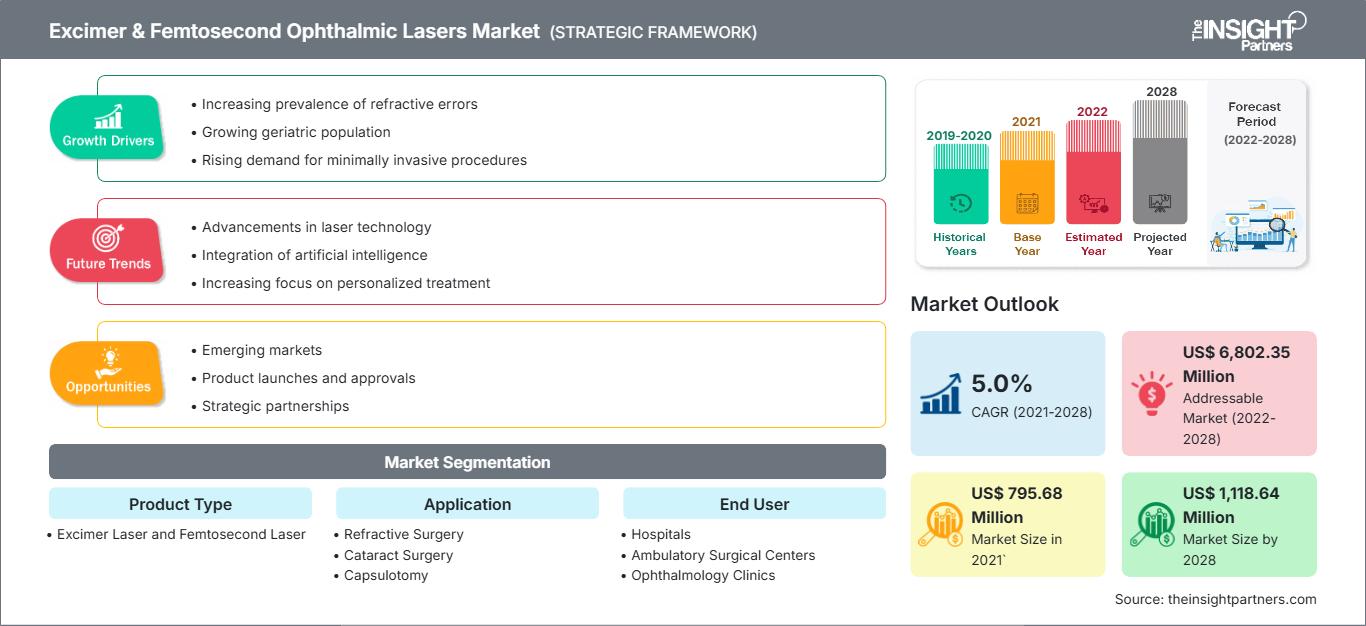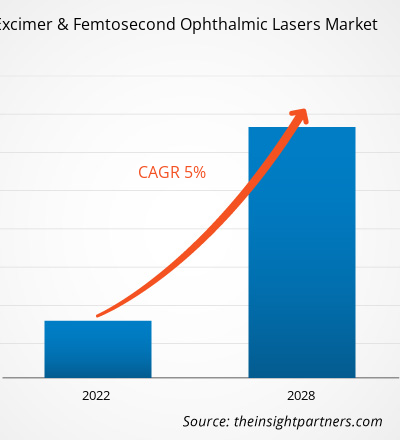Le marché des lasers ophtalmiques excimères et femtosecondes devrait atteindre 1 118,64 millions de dollars américains d'ici 2028, contre 795,68 millions de dollars américains en 2021 ; il devrait croître à un TCAC de 5,0 % entre 2021 et 2028.
Couverture du rapport
La croissance du marché des lasers ophtalmiques excimer et femtoseconde est attribuée à des facteurs tels que l'augmentation de la population âgée et l'augmentation du nombre de chirurgies de la cataracte et réfractives. Cependant, le coût élevé des interventions et des dispositifs ophtalmologiques freine la croissance du marché.
Personnalisez ce rapport en fonction de vos besoins
Vous bénéficierez d’une personnalisation sur n’importe quel rapport - gratuitement - y compris des parties de ce rapport, ou une analyse au niveau du pays, un pack de données Excel, ainsi que de profiter d’offres exceptionnelles et de réductions pour les start-ups et les universités
Marché des lasers ophtalmiques excimères et femtosecondes: Perspectives stratégiques

-
Obtenez les principales tendances clés du marché de ce rapport.Cet échantillon GRATUIT comprendra une analyse de données, allant des tendances du marché aux estimations et prévisions.
Aperçu du marché
Augmentation significative de la population âgée
L'augmentation de la population gériatrique dans des pays comme les États-Unis, le Royaume-Uni, le Canada, le Japon, la Chine, l'Inde et la Corée du Sud est due à la modernisation des établissements de santé et à l'amélioration des services de santé, ce qui augmente l'espérance de vie dans ces pays. Selon les données de l'OMS de février 2018, la population gériatrique devrait passer de 12 % en 2015 à 22 % d'ici 2050. Selon le Bureau du recensement des États-Unis, le nombre de personnes âgées de 65 ans et plus aux États-Unis devrait passer de 46 millions en 2016 à plus de 98 millions d'ici 2060, tandis que leur part dans la population passerait d'environ 15 % à environ 24 % au cours de cette période. Selon le rapport 2017 des Nations Unies sur le vieillissement de la population mondiale, l'Europe affichait en 2017 le pourcentage le plus élevé au monde (soit 25 %) de personnes âgées de plus de 60 ans. De plus, d'ici 2050, toutes les régions du monde, à l'exception de l'Afrique, compteront environ 25 % ou plus de leur population âgée de 60 ans et plus, et les pays sous-développés et en développement représenteront environ 80 % de cette croissance.
La perte de vision est un problème de santé majeur chez les personnes âgées. La dégénérescence maculaire liée à l'âge, le glaucome, la cataracte et la rétinopathie diabétique comptent parmi les causes les plus fréquentes de perte de vision chez les personnes de ce groupe d'âge. La dégénérescence maculaire liée à l'âge entraîne une perte de la vision centrale. Une lésion du nerf optique et une perte du champ visuel peuvent survenir à la suite d'un glaucome primitif à angle ouvert. Comme cette maladie peut être asymptomatique au début, les personnes âgées ont besoin de contrôles réguliers. Bien que la cataracte soit la cause fréquente de problèmes visuels chez ces personnes, elle peut généralement être retirée par chirurgie. La rétinopathie diabétique est également fréquente chez les personnes âgées, aux premiers stades du diabète ou au moment du diagnostic. Un examen mydriatique est recommandé dès le diagnostic de diabète, suivi d'une consultation annuelle par la suite.
Selon l'American Institute of Ophthalmology, environ 24,4 millions de personnes de moins de 40 ans subissent une opération de la cataracte, et environ 5 % des Américains en subissent une avant 75 ans. De plus, les cas de glaucome sont en augmentation et touchent plus de 2,7 millions d'Américains de 40 ans et plus. De nouvelles maladies oculaires, comme la dégénérescence maculaire liée à l'âge, qui touche plus de 2,1 millions d'Américains de 50 ans et plus, peuvent entraîner une perte de vision grave. On observe ainsi une adoption très élevée de nouvelles technologies, telles que les lasers femtosecondes, en chirurgie de la cataracte, ce qui implique un investissement initial important mais promet des améliorations des résultats pour les patients. Ainsi, l'augmentation de la population gériatrique alimente la croissance du marché des lasers ophtalmiques excimères et femtosecondes.
Informations basées sur le type de produit
En fonction du type de produit, le marché des lasers ophtalmiques excimères et femtosecondes est segmenté en laser excimère et laser femtoseconde. Le segment du laser femtoseconde devrait dominer le marché en 2021 et conserver sa domination entre 2021 et 2028. De plus, ce même segment devrait également connaître la croissance la plus rapide au cours des prochaines années.
Informations basées sur les applications
En fonction des applications, le marché des lasers excimères et femtosecondes Le marché des lasers ophtalmiques femtosecondes est segmenté en chirurgie réfractive, chirurgie de la cataracte, capsulotomie, trabéculoplastie et diagnostic. Le segment de la chirurgie réfractive devrait détenir la plus grande part de marché en 2021, tandis que le segment de la chirurgie de la cataracte devrait enregistrer le TCAC le plus élevé du marché au cours de la période de prévision.
Informations basées sur l'utilisateur final
Selon l'utilisateur final, le marché des lasers ophtalmiques excimères et femtosecondes est segmenté en hôpitaux, cliniques ophtalmiques et centres de chirurgie ambulatoire. Le segment des hôpitaux devrait détenir la plus grande part de marché en 2021. Cependant, le segment des cliniques ophtalmiques devrait enregistrer le TCAC le plus élevé du marché au cours de la période de prévision.
Le lancement et l'approbation de produits sont les stratégies couramment adoptées par les entreprises pour étendre leur présence mondiale et leur portefeuille de produits. Les entreprises du marché des lasers ophtalmiques excimères et femtosecondes se concentrent sur la stratégie de collaboration pour élargir leur clientèle, ce qui, à son tour, leur permet de maintenir leur nom de marque à travers le monde.
Marché des lasers ophtalmiques excimères et femtosecondes
Les tendances et facteurs régionaux influençant le marché des lasers ophtalmiques excimères et femtosecondes tout au long de la période de prévision ont été analysés en détail par les analystes de The Insight Partners. Cette section aborde également les segments de marché et la répartition géographique du marché des lasers ophtalmiques excimères et femtosecondes en Amérique du Nord, en Europe, en Asie-Pacifique, au Moyen-Orient et en Afrique, ainsi qu'en Amérique du Sud et en Amérique centrale.Portée du rapport sur le marché des lasers ophtalmiques excimères et femtosecondes| Attribut de rapport | Détails |
|---|---|
| Taille du marché en 2021` | US$ 795.68 Million |
| Taille du marché par 2028 | US$ 1,118.64 Million |
| TCAC mondial (2021 - 2028) | 5.0% |
| Données historiques | 2019-2020 |
| Période de prévision | 2022-2028 |
| Segments couverts |
By Type de produit
|
| Régions et pays couverts |
Amérique du Nord
|
| Leaders du marché et profils d'entreprises clés |
|
Densité des acteurs du marché des lasers ophtalmiques excimères et femtosecondes : comprendre son impact sur la dynamique commerciale
Le marché des lasers ophtalmiques excimères et femtosecondes connaît une croissance rapide, portée par une demande croissante des utilisateurs finaux, due à des facteurs tels que l'évolution des préférences des consommateurs, les avancées technologiques et une meilleure connaissance des avantages du produit. Face à cette demande croissante, les entreprises élargissent leur offre, innovent pour répondre aux besoins des consommateurs et capitalisent sur les nouvelles tendances, ce qui alimente la croissance du marché.
- Obtenez le Marché des lasers ophtalmiques excimères et femtosecondes Aperçu des principaux acteurs clés
Marché des lasers ophtalmiques excimères et femtosecondes – par type de produit
- Laser femtoseconde
- Laser excimère
Marché des lasers ophtalmiques excimères et femtosecondes – par application
- Chirurgie réfractive
- Chirurgie de la cataracte
- Capsulotomie
- Trabéculoplastie
- Diagnostics
Marché des lasers ophtalmiques excimères et femtosecondes – par utilisateur final
- Hôpitaux
- Cliniques ophtalmiques
- Centres de chirurgie ambulatoire
Marché des lasers ophtalmiques excimères et femtosecondes – par utilisateur final par géographie
- Amérique du Nord
- États-Unis
- Canada
- Mexique
- Europe
- France
- Allemagne
- Italie
- Royaume-Uni
- Espagne
- Reste de l'Europe
- Asie-Pacifique (APAC)
- Chine
- Inde
- Corée du Sud
- Japon
- Australie
- Reste de l'Asie-Pacifique
- Moyen-Orient et Afrique (MEA)
- Afrique du Sud
- Arabie saoudite
- EAU
- Reste du Moyen-Orient et de l'Afrique
- Amérique du Sud et centrale (SCAM)
- Brésil
- Argentine
- Reste de l'Amérique du Sud et centrale
Profils d'entreprises
- Bausch Health Companies Inc.
- Alcon Inc.
- ZEISS International
- NIDEK CO., LTD
- IVIS TECHNOLOGIES
- EXCELSIUS MEDICAL GMBH
- Ziemer Ophthalmic Systems
- SCHWIND EYE-TECH-SOLUTIONS
- LENSAR, Inc.
- NKT Photonics A/S
- Analyse historique (2 ans), année de base, prévision (7 ans) avec TCAC
- Analyse PEST et SWOT
- Taille du marché Valeur / Volume - Mondial, Régional, Pays
- Industrie et paysage concurrentiel
- Ensemble de données Excel
Rapports récents
Rapports connexes
Témoignages
Raison d'acheter
- Prise de décision éclairée
- Compréhension de la dynamique du marché
- Analyse concurrentielle
- Connaissances clients
- Prévisions de marché
- Atténuation des risques
- Planification stratégique
- Justification des investissements
- Identification des marchés émergents
- Amélioration des stratégies marketing
- Amélioration de l'efficacité opérationnelle
- Alignement sur les tendances réglementaires






















 Obtenez un échantillon gratuit pour - Marché des lasers ophtalmiques excimères et femtosecondes
Obtenez un échantillon gratuit pour - Marché des lasers ophtalmiques excimères et femtosecondes